Golfing Our Way To West Texas

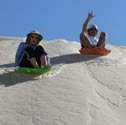
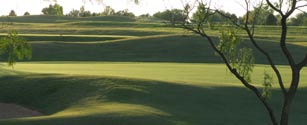
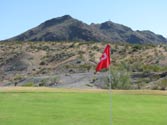


Our calling (somebody had to do it) was to head West from Dallas for two weeks of fun new adventures golfing, camping, hiking, biking, houseboating, caving, eating, drinking, and in general just having a good ole time. Our destination was the Terlingua Chili Cookoff and Big Bend National Park, but we can’t seem to go anywhere without playing golf, so the main focus of this article will be our golfing experiences on our way to Big Bend and back.
On the way to Big Bend, the first stop was to play golf in Abilene at Diamondback Golf Club. To be frank, we didn’t have high hopes for a day of exciting golf – Abilene is not known for it’s scenic beauty or hilly terrain, in fact, it’s a tad dry, flat, and basically desert. Wow, were we surprised when we parked the motorhome at Diamondback club house – the green grass, rolling hills, and multitude of trees shocked us as did the quality of this fantastic course.

Diamondback was designed and built by Charles Coody, who resides in Abilene and was the 1971 Masters Champion. The course is located on 220 acres of treed rolling terrain and the changes in elevation present some beautiful scenic views of the surrounding countryside. When we played, the Tiffway 419 bermuda fairways were on the verge of going dormant, but were still in very good condition as were the bent grass greens. At 6977 yards from the tips (rating 73.7 and slope of 134), Diamondback is a fun and challenging track that offers a little bit of everything at a very reasonable price for the quality of the course. You’ll find elevation changes, rolling fairways, dog legs, creeks, ravines, and lots of cactus spines if your ball happens to find its way out of the rather narrow fairways. We gave Diamondback 8.2 stars and you can read our review of Diamondback to learn more about the course. Well worth the stop if you’re in Abilene.
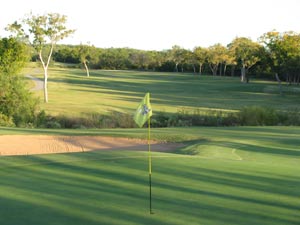
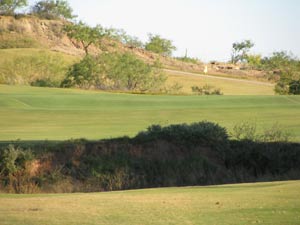
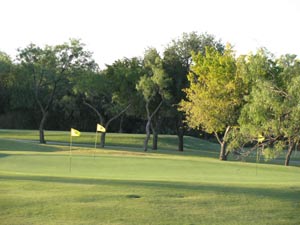 Every once in a while we spend some time doing something besides golf and given our tight schedule, we didn’t have time to fit in golf again until we got to Marfa. Here are some of the fun things we did until we could get back on the links:
Every once in a while we spend some time doing something besides golf and given our tight schedule, we didn’t have time to fit in golf again until we got to Marfa. Here are some of the fun things we did until we could get back on the links:
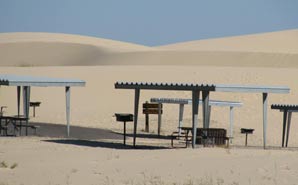
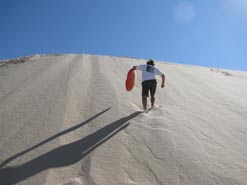 Down the Dunes – just west of Odessa is Monahans State Park which is 3840 acres of wind sculptured living sand dunes some of which are up to 70 feet tall. So we put on our kid hats, rented a sand disc, and headed to the dunes for a few hours of hiking (which is not that easy in soft sand) in the dunes and climbing up and then discing or rolling down the sand dunes. Three months later we’re still finding sand in places we never thought it could go! Good time. Check out this Review of Monahans Sandhills State Park to learn more about this great State Park.
Down the Dunes – just west of Odessa is Monahans State Park which is 3840 acres of wind sculptured living sand dunes some of which are up to 70 feet tall. So we put on our kid hats, rented a sand disc, and headed to the dunes for a few hours of hiking (which is not that easy in soft sand) in the dunes and climbing up and then discing or rolling down the sand dunes. Three months later we’re still finding sand in places we never thought it could go! Good time. Check out this Review of Monahans Sandhills State Park to learn more about this great State Park. 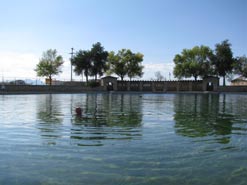
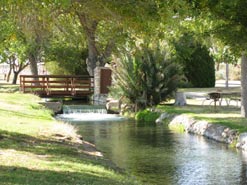 Swimming in the Spring – another stop to break up the drive and get us out of the car was at Balmorhea State Park. Balmorhea is known for having one of the best swimming holes in Texas – the world’s largest artesian spring fed swimming pool at 77,053 square feet. We enjoyed a couple hours swimming in the cool and refreshing water before it was back to the motorhome to continue our journey. Here is a link to the review of Balmorhea State Park. I think we left enough of the Monahans Sandhills Park sand at Balmorhea to help create a new beach.
Swimming in the Spring – another stop to break up the drive and get us out of the car was at Balmorhea State Park. Balmorhea is known for having one of the best swimming holes in Texas – the world’s largest artesian spring fed swimming pool at 77,053 square feet. We enjoyed a couple hours swimming in the cool and refreshing water before it was back to the motorhome to continue our journey. Here is a link to the review of Balmorhea State Park. I think we left enough of the Monahans Sandhills Park sand at Balmorhea to help create a new beach. 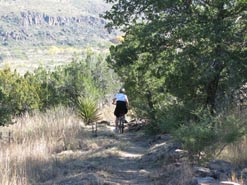
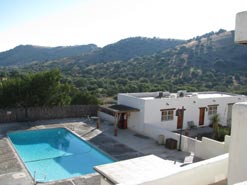 Hiking the Hills – it was a short drive from Balmorhea to Davis Mountains State Park where we spent a couple days hiking, mountain biking, staying clear of the wild animals (the javalena scared the dickens out of the girls!), and exploring the area. Davis Mountains State Park is a fantastic park set in a valley surrounded by the Davis Mountains – a wide variety of great hiking trails, tough mountain biking trails, fantastic birding, magnificent panoramic views, lots of wildlife, good campsites, and a cool lodge with a restaurant.
Hiking the Hills – it was a short drive from Balmorhea to Davis Mountains State Park where we spent a couple days hiking, mountain biking, staying clear of the wild animals (the javalena scared the dickens out of the girls!), and exploring the area. Davis Mountains State Park is a fantastic park set in a valley surrounded by the Davis Mountains – a wide variety of great hiking trails, tough mountain biking trails, fantastic birding, magnificent panoramic views, lots of wildlife, good campsites, and a cool lodge with a restaurant. 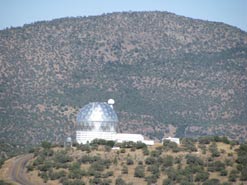
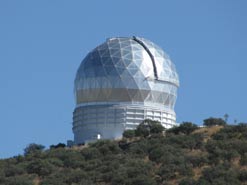 Searching the Sun for Sunspots – fifteen minutes from Davis Mountains State Park, through some beautiful scenery, is McDonald Observatory which is open for public tours. At first we were skeptical about spending time on the tour, but it turned out to be fantastic. Live shots and tour of the sun, an excellent tour guide, up close and personal with two huge telescopes, and fantastic scenery from the top of the observatory made this an informative and interesting tour worth the time and fees.
Searching the Sun for Sunspots – fifteen minutes from Davis Mountains State Park, through some beautiful scenery, is McDonald Observatory which is open for public tours. At first we were skeptical about spending time on the tour, but it turned out to be fantastic. Live shots and tour of the sun, an excellent tour guide, up close and personal with two huge telescopes, and fantastic scenery from the top of the observatory made this an informative and interesting tour worth the time and fees.
Enough of that tourist stuff, we were ready for more golf. Once you leave Highway 20 at Pecos (unfortunately, there was no time to play Reeves Country Golf Course in Pecos) heading toward Terlingua, Lajitas, and Big Bend, you don’t have a lot of choices for golf – see our West Texas Golf Map to find a course. To satisfy our craving for more golf, we spent the night in Marfa so we could play a course whose claim to fame is “The golf course with the highest elevation in Texas” – Marfa Municipal Golf Course. What do you think of when you hear “highest elevation”? We were expecting a course high in the mountains of west Texas with elevation changes, tall trees, lush fairways, waterfalls, clear mountain streams, and lots of challenges – wrong again! We forgot we were in Texas not Colorado and what we found was that Marfa was perfectly flat, had one man made trough for a water hazard, more trees than expected, and a fairway that was just a little greener and better groomed than the desert! Oh, and the golf carts looked like they had just returned from Saturday Night’s Destruction Derby – hard to tell if they were the winner or loser from that night’s derby! When was the last time you saw a three wheel golf cart? But it was a beautiful day and any day on the links is a good day plus Marfa Muni is a course where you can turn in a great score – doesn’t get much better than that!
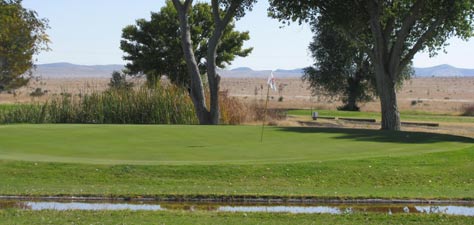

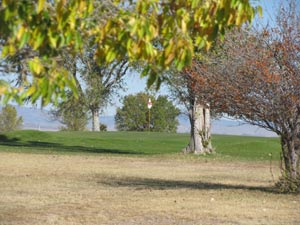
Our next stop was Terlingua, home of the infamous Terlingua Chili Cookoff. We spent a couple fun afternoons at the two chili cookoffs – what a bunch of wild, fun loving, chili heads, the vast majority of whom are there to drink beer and party, rather than enter a chili cookoff. The live music each night was great, the contest for the Chili Team Showmanship award was hilarious, and the people watching was unbelievable! The chili cookoff split in two a few years back – one is a national competition with previous State winners and the other is a Texas chili cookoff. The national cookoff attracts a much larger and younger crowd that outside of the 30 or 40 cookoff teams is there to party and it can get pretty wild and exciting – leave your inhibitions and kids at home at this one. The other cookoff is smaller, with a more serious older crowd – but they still know how to party and have fun in the desert!
Between cookoffs, we had to play the nine hole Quicksilver Challenge Golf Course in Terlingua. What a unique and challenging experience! The first challenge is to find the pro shop (turns out there is no pro shop – pay your fee in the hotel lobby and they’ll have a cart brought up) and then find the first hole. After wondering around in the desert for 10 minutes, we went back and asked for directions to the first hole, which were “follow that thar dirt road over yonder, turn left, and then look for the tee box – it will be that semi green grass instead of the desert.” Once we found the first hole and the tee box, we could see a patch of green in the distance with what appeared to be a flag, but we couldn’t distinguish the fairway from the desert! We teed up, and hit away after we determined that we had to carry a ravine and then the desert to land in a small narrow landing zone surrounded by cactus just daring you to get near them. Each of us then watched our ball head to the sage brush, cactus, and/or arroyo. Same thing on the second shot – it seems none of us could find the fairway or the small elevated and well protected greens! Normally, we play skins and wolf, but after losing all the balls and spending too much time on the first hole, we gave up on skins and just played “bingo, bango, bongo” and agreed that when you found any ball in the rough, you stopped looking for your ball and dropped in any spot that you could hit from without getting dust in your face, killing local fauna, or chipping a rock farther than your ball. Without these new rules, it would have taken us two days to play 18 holes.
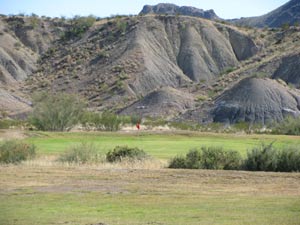
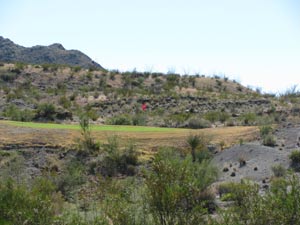
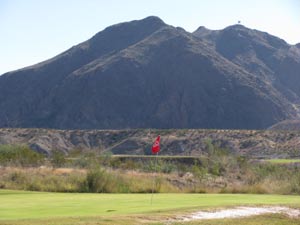 Quicksilver Challenge is desert and target golf at its best. The course has been neglected over the last year and Carefree Resorts has recently purchased the hotel, RV park, store, and golf course. With some water, maintenance, and tender loving care, this could be a fantastic course and we understand that Carfree plans to make some improvements. Overall, Quicksilver Challenge was our longest round of golf ever, eat at least one and usually two balls per hole, was the most challenging 9 holes we’ve played, demanded strategy and target golf on each hole, required tweezers to remove the cactus, and a shower to get rid of the dust, yet we still had a good time and would play it again. And we added more sand to the collection in our shoes, various body parts, clothes, car, and motorhome – a new beach was starting to take shape!
Quicksilver Challenge is desert and target golf at its best. The course has been neglected over the last year and Carefree Resorts has recently purchased the hotel, RV park, store, and golf course. With some water, maintenance, and tender loving care, this could be a fantastic course and we understand that Carfree plans to make some improvements. Overall, Quicksilver Challenge was our longest round of golf ever, eat at least one and usually two balls per hole, was the most challenging 9 holes we’ve played, demanded strategy and target golf on each hole, required tweezers to remove the cactus, and a shower to get rid of the dust, yet we still had a good time and would play it again. And we added more sand to the collection in our shoes, various body parts, clothes, car, and motorhome – a new beach was starting to take shape!
Between golf, the Chili Cookoff, hob knobbing with the locals at some of the bars, and enjoying some good restaurants, we found some time to go:
Hiking – Big Bend National Park is outstanding – beautiful scenery, excellent camping, good lodging, an ok restaurant, and fantastic hiking trails. We spent three afternoons exploring different portions of the park – the Chihuahuan desert landscape, the majestic Chisos Mountains, and the Rio Grande river valley.
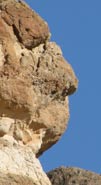
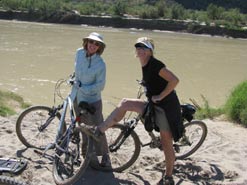 In the Chihuahan desert we rode bikes along the road and by the Rio Grande River, through the mud from the recent floods (the bikes are still covered with Rio Grande River mud – could this replace or compliment our sand collection?), and took a couple great hikes through a canyon, into a deep carved arroyo, and across the desert.
In the Chihuahan desert we rode bikes along the road and by the Rio Grande River, through the mud from the recent floods (the bikes are still covered with Rio Grande River mud – could this replace or compliment our sand collection?), and took a couple great hikes through a canyon, into a deep carved arroyo, and across the desert. - The scenery is unbelievable and the rock formations are amazing – can you see the “old man of the mountain?” One of the trails lead to the entrance of Santa Elena Canyon where the faults and Rio Grande River have carved narrow sheer cliffs up to 1500 feet above the river.
- The Chisos mountains are up to 7800′ above sea level and offering a
 wide variety of geologic formations,
wide variety of geologic formations, 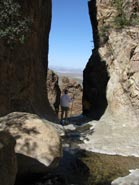 panoramic views, and lots of wildlife. There are a number of fantastic hikes from easy to strenuous and hours to multi day trips. We hiked the Lost Mines trail which is a 5 mile round trip relatively steep climb offering majestic panoramic views of the mountains and desert. The Windows trail was our favorite – it descends to a narrow water carved slot which ends with a sheer drop off to the desert below and an unbelievable view of the desert, mountains, and Rio Grande River. The Chisos Mountain Lodge is near the top and center of this section of the park and it has lodging, a restaurant, a gift and souvenir shop, and an outdoor patio with a fabulous view. Tent and small RV (the road is too windy for large RVs) camping is available just down the road from the lodge.
panoramic views, and lots of wildlife. There are a number of fantastic hikes from easy to strenuous and hours to multi day trips. We hiked the Lost Mines trail which is a 5 mile round trip relatively steep climb offering majestic panoramic views of the mountains and desert. The Windows trail was our favorite – it descends to a narrow water carved slot which ends with a sheer drop off to the desert below and an unbelievable view of the desert, mountains, and Rio Grande River. The Chisos Mountain Lodge is near the top and center of this section of the park and it has lodging, a restaurant, a gift and souvenir shop, and an outdoor patio with a fabulous view. Tent and small RV (the road is too windy for large RVs) camping is available just down the road from the lodge. 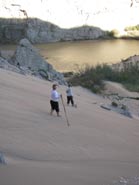
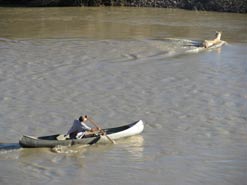 The river valley is home to an RV park and campground, access to the Rio Grande River, and several good trails. One of the trails leads to a hot springs, but unfortunately it was closed due to the recent floods. We hiked the Boquillas Canyon trail which goes up and down the hills, along the river bed, and to the entrance to Boquillas Canyon. Just short of the canyon entrance is a tall sand dune that’s fun to hike up and run or roll down – we added more sand to what we had already accumulated at Monohans Sandhills and Quicksilver Challenge golf course! We got a picture of a Mexican who rides his horse to the river, jumps in his canoe and persuades his horse (a few stones to the rump and a lot of yelling) to swim across to the other side, where he mounts the horse, rides up the hiking trail and leaves handmade souvenirs and hiking sticks for a donation. Then he rides back down, canoes across the river, and he and his horse trot into the sunset and back home – another tough day at work.
The river valley is home to an RV park and campground, access to the Rio Grande River, and several good trails. One of the trails leads to a hot springs, but unfortunately it was closed due to the recent floods. We hiked the Boquillas Canyon trail which goes up and down the hills, along the river bed, and to the entrance to Boquillas Canyon. Just short of the canyon entrance is a tall sand dune that’s fun to hike up and run or roll down – we added more sand to what we had already accumulated at Monohans Sandhills and Quicksilver Challenge golf course! We got a picture of a Mexican who rides his horse to the river, jumps in his canoe and persuades his horse (a few stones to the rump and a lot of yelling) to swim across to the other side, where he mounts the horse, rides up the hiking trail and leaves handmade souvenirs and hiking sticks for a donation. Then he rides back down, canoes across the river, and he and his horse trot into the sunset and back home – another tough day at work.
Rafting – you can’t come to the Big Bend area without a rafting, canoeing, or kayaking trip down the Rio Grande river. We took an all day raft trip that led us through the desert and into the stunning Santa Elena canyon with its sheer 1500′ limestone walls and infamous Rockslide rapids which can be a class IV rapid. The Rio Grande was still well above normal and flowing much faster than normal due to the September flooding, which made this trip through the canyon possible and even more enjoyable. Fun trip and you can read more about it in our Rafting the Rio Grande article.
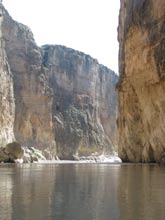
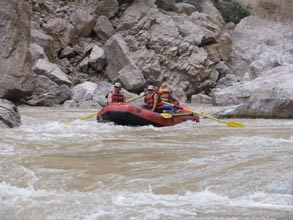
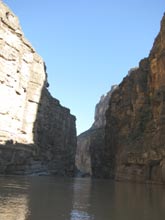
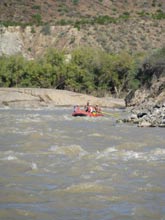
After all that fun, we left Terlingua to head 12 miles down highway 170 to spend a couple days enjoying the spa and resort lifestyle at Lajitas Resort & Spa – what a special place and you can read our review of Lajitas Golf Resort to learn more about the resort and our fun adventures. We also hoped that the Ambush Golf Course would be open – unfortunately it was still closed due to the September flood. So instead of golfing, we:
- we ate and drank and played games – Lajitas Resort served an excellent 3 course dinner, you can’t beat the atmosphere at the Thirsty Goat Saloon, and dominos and cribbage go everywhere we go
- took a very fun tour on some fast ATVs up and down the hills, through the desert, and across arroyos and learned a lot from our guide about the desert, the fauna, the geology, and the local history
- went mountain biking on a couple of the numerous Lajitas mountain bike trails that crisscross each other through the desert and into the hills – if you want some exercise on pretty rough trails, you might enjoy this – my preference would have been to sip a few margaritas at the resort’s Thirsty Goat Salon, spend time in the pool, or ride horses. From the mountain biking and ATV tour, we were able to collect some additional sand and dust for our growing collection!
- enjoyed a massage to work out some of the kinks
- took the scenic drive on Highway 170 which winds 50 miles up and down the mountains and along the Rio Grande River from Lajitas to Presidio – Automobile Magazine rated this route as one of the 20 most outstanding drives in America and National Geographic Magazine rated it as one of the most scenic roads in the country! We wanted to take it all the way to Presidio for lunch and then a side trip across the border into Mexico, but the September flood had wiped out a section of the highway
We were very disappointed that Ambush Golf Course was still closed because it has won a number of accolades and from what we could tell it looked like a fabulous course. We rode bikes around what was left of the course and rated it and it made our Top 20 Favorite Texas Courses list. Prior to the flooding, based on our ride around the course and pictures we’ve seen, the course was in fantastic condition (lush and green in contrast to the surrounding arid and brown desert landscape); challenging with contoured fairways and steep faced bunkers; numerous dog legs and other challenges; stunning scenery with the mountains, desert, and Rio Grande; and some very unique holes. Four of the holes were on an island surrounded by the Rio Grande and on one hole you drive across the Rio Grande to a green in Mexico – the only par 1 hole we know of and closest to the hole wins the skin! The front nine was under water for weeks and the flood wiped out the front nine and the entire irrigation system – what a shame! Resort management is committed to reopening the front nine by March 2009 and has plans to relocate the back nine away from the Rio Grande. We can’t wait to get back to play the Ambush. Here are some pictures of Ambush before the flood (hole #11 where you drive across the river), the front nine under water, and one of the front nine holes after the water receded and the fairways have died because of no water – sad!
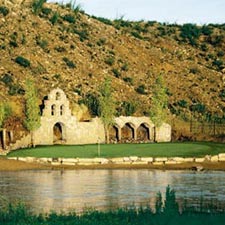
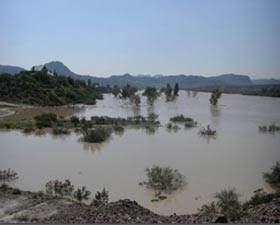
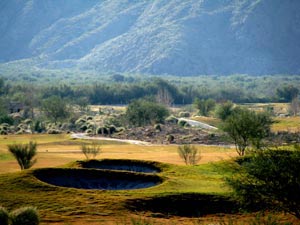
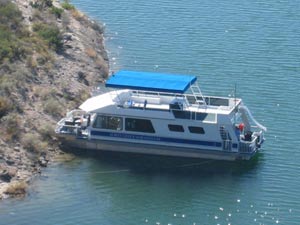
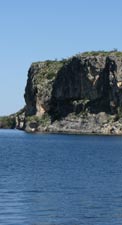 From Lajitas, we went to Lake Amistad for three days on a houseboat – what a fun but short trip hiking, fishing, and exploring the cool blue waters and scenic bluffs of Lake Amistad. Here is a link to the houseboating article on this part of the trip. If was tough getting off that 54′ houseboat and back in the motorhome, knowing that the trip was coming to an end – the good news was we still had a few fun days left.
From Lajitas, we went to Lake Amistad for three days on a houseboat – what a fun but short trip hiking, fishing, and exploring the cool blue waters and scenic bluffs of Lake Amistad. Here is a link to the houseboating article on this part of the trip. If was tough getting off that 54′ houseboat and back in the motorhome, knowing that the trip was coming to an end – the good news was we still had a few fun days left.
From the houseboat, we headed north to the Caverns of Sonora for what turned out to be a highlight of the entire trip. We took the normal cavern tour which was amazing but the Adventure Tour was awesome – off the beaten path, crawling through very narrow passageways, rappelling down a 50′ wall in the dark, and lots more!
Guess what, after crawling through the narrow passageways, we added more sand, dust, and some dirt to our growing sand collection. To learn more about this great experience, click on Caverns of Sonora.
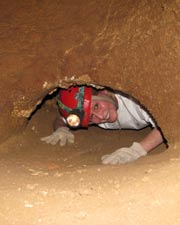
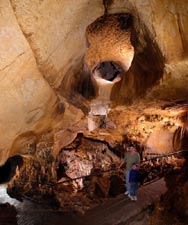
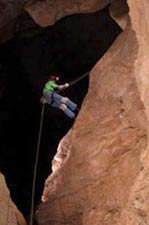
Golf fever was setting in (after all, it had been at least 5 days since we last played), so on the final leg back to the Dallas Fort Worth metroplex , we had to stop at Squaw Creek Golf Course, which is in Willow Park just west of Fort Worth. Squaw Creek Golf Course is one of those hidden gems that you wish you had know about a long time ago. The course is owned by Lockheed Martin Aircraft and is for Lockheed employees as well as public use. Dallas Morning News rated Squaw Creek “Best Bang For The Buck” because it is a fun course, in very good condition, and a real bargain. The terrain is rolling hills with trees lining both sides of most of the fairways. You’ll find a little bit of everything here to make this a fun and challenging course – elevated tee boxes, a 22 acre lake, rolling hills, slopping fairways, blind shots, narrow approaches, and both uphill and downhill bunker protected greens. The course is tough, but fair and won’t beat your brains out. There is no in-course out of bounds, but if you spray the ball, you’re in trouble. Well worth the stop for a great round of golf.
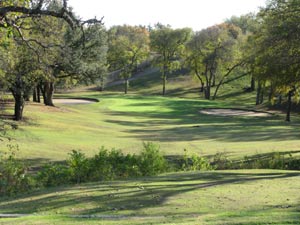

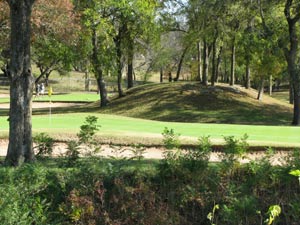 What a fun and adventurous trip – to read more about any of the golf courses you can click on any of the golf course links in this article and to learn more on our trip, click on any of the links in the article or on this link: Exploring West Texas. By the way, we collected all the sand from Monahans sand dunes, the Boquillas Canyon sandunes, golf at Quicksilver, biking in the mud, caving, and the ATV tour and started a fantastic sandpile for the grandkids!
What a fun and adventurous trip – to read more about any of the golf courses you can click on any of the golf course links in this article and to learn more on our trip, click on any of the links in the article or on this link: Exploring West Texas. By the way, we collected all the sand from Monahans sand dunes, the Boquillas Canyon sandunes, golf at Quicksilver, biking in the mud, caving, and the ATV tour and started a fantastic sandpile for the grandkids!